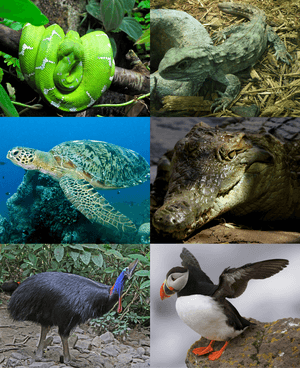Sauropsid facts for kids
Quick facts for kids Sauropsids |
|
|---|---|
 |
|
| Row 1: emerald tree boa and tuatara Row 2: green sea turtle and Nile crocodile Row 3: Southern cassowary and Atlantic puffin |
|
| Scientific classification | |
| Subgroups | |
Sauropsids are a big group of land vertebrates. This group includes all living reptiles and birds, plus their ancient fossil relatives. They are one of two main groups that grew from early egg-laying animals called amniotes. This happened during the first part of the Carboniferous period, over 300 million years ago.
The other main group that came from amniotes is called synapsids. This group eventually led to all mammals. So, both reptiles and mammals came from a common ancestor, but they split off a very long time ago!
Today, living sauropsids include lizards, snakes, turtles, crocodiles, and birds. Many sauropsids are now extinct, meaning they no longer exist. These include famous groups like dinosaurs, pterosaurs (flying reptiles), plesiosaurs (marine reptiles), and ichthyosaurs (fish-like marine reptiles).
Contents
How Land Animals Evolved
Life on Earth started in the water. Over millions of years, some fish began to adapt to life on land. Here's a simple look at how land animals, or tetrapods, evolved:
- Fish with strong, fleshy fins, like lobe-finned fish, were important.
- These fish included coelacanths and lungfish.
- From these, a group called tetrapodomorphs evolved. These were "fishapods," meaning they had features of both fish and early land animals.
The very first tetrapods lived in water. We have found clear tracks from the mid-Devonian period that show these early tetrapods. These tracks are 18 million years older than other early tetrapod fossils!
These early tetrapods were not fully land animals. They lived in wet places like swamps, shallow wetlands, coastal lagoons, and even brackish river deltas. Some even lived in shallow marine areas.
The Big Step to Land
There's a period of about 30 million years, known as Romer's Gap, where we have very few fossils of early tetrapods. This makes it hard to see exactly how they moved from water to land. However, some new fossils, like Pederpes, have been found that help fill this gap.
Eventually, some fishapods became mostly land-based. One group kept laying their eggs in water; these became the amphibians (like frogs and salamanders). Another group developed a special way to lay eggs on land. These were the amniotes. Their big invention was the cleidoic egg, which has a shell and membranes that protect the embryo and keep it from drying out. This meant they didn't need water to lay their eggs!
Around the middle of the Carboniferous period, the amniotes split into two main lines:
- One line led to all kinds of reptiles, which we call the Sauropsida.
- The other line eventually led to mammals, which we call the Synapsida.
It's not quite right to say "mammals evolved from reptiles." Instead, both groups came from those early amniotes. Modern reptiles and modern mammals are very different because they have both been evolving for over 300 million years since that split!
Sauropsid Family Tree
Scientists use something called a cladogram to show the "family tree" of different animal groups. The cladogram below shows how sauropsids are related. This tree is based on a study from 2013 by M.S. Lee.
Scientists use different types of information to build these trees, including genetic (DNA) studies and fossil (bone structure) data. For example, genetic studies strongly suggest that turtles are a type of diapsid reptile, even though they look very different from lizards or birds.
| Sauropsida |
|
|||||||||||||||||||||||||||||||||||||||||||||||||||||||||||||||||||||||||||||||||||||||||||||||||||||||||||||||||||||||||||||||||||||||||||||
Images for kids
-
The Berlin specimen of Archaeopteryx lithographica, a very important fossil that helped show birds are part of the reptile family tree.
-
Mesozoic sauropsids: the dinosaurs Europasaurus and Iguanodon, and the early bird Archaeopteryx perched on the foreground tree stump.
See also
 In Spanish: Saurópsidos para niños
In Spanish: Saurópsidos para niños



